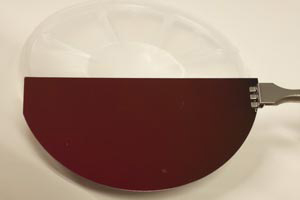| Posted: Apr 20, 2016 |
Cool method for making waveguides
(Nanowerk News) A low-temperature method to produce films based on silicon and nitrogen, which can be used to channel light in devices, has been developed by A*STAR researchers ("Exploring High Refractive Index Silicon-Rich Nitride Films by Low-Temperature Inductively Coupled Plasma Chemical Vapor Deposition and Applications for Integrated Waveguides").
|
 |
| A silicon-rich nitride film grown by inductively-coupled plasma chemical vapor deposition on a silicon substrate with a layer of silicon dioxide. (Image: A*STAR Data Storage Institute)
|
|
Silicon is very a familiar material because of its prevalence in electronic devices, and is increasingly being used in optical and electro-optical devices as well. In particular, it is used to guide light along narrow stripes in components known as waveguides. While silicon has many advantages, it suffers from high losses when used in waveguides as a result of nonlinear absorption at the wavelength used for telecommunications (1,550 nanometers).
|
|
One way to reduce these losses is to incorporate nitrogen atoms to produce so-called silicon-rich nitride — a material whose nitrogen content is intermediate between pure silicon and silicon nitride. But, the usual techniques for making silicon-rich nitride require high temperatures, which renders the process incompatible with the standard technology used for constructing integrated circuits.
|
|
Now, Doris Ng at the A*STAR Data Storage Institute and co-workers have discovered a way to make silicon-rich nitride films (see image) at temperatures as low as 250 degrees Celsius, which is much lower than the temperatures usually used to produce the material. They used a plasma — a gas that has been energized to the point that electrons have been stripped from its molecules — to deposit a tailored mixture of silicon and nitrogen atoms onto a substrate.
|
|
By changing the process parameters, the researchers were able to vary the refractive index of the films. Under certain conditions, they were able to achieve a high refractive index of 3.08 at the telecommunication wavelength. This refractive index is high enough to make it suitable for use in waveguides, but not high enough to cause detrimental nonlinear effects.
|
|
The team demonstrated the potential of their films by making waveguides from them. “The waveguide we made using the silicon-rich nitride with the highest refractive index exhibits very good nonlinear performance,” says Doris.
|
|
The study heralds the beginning of a fruitful partnership. “This work is a collaborative project between A*STAR Data Storage Institute and Singapore University of Technology and Design,” notes Ng. “I work on material development, while my collaborator, Dawn Tan, specializes in nonlinear optics. I think it’s the perfect team for our project. We are still at the beginning but have been very encouraged by the results obtained so far.”
|
|
The team plans to further optimize the material to reduce losses and hence enhance device performance.
|

